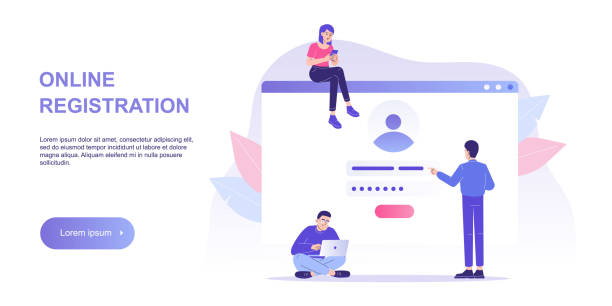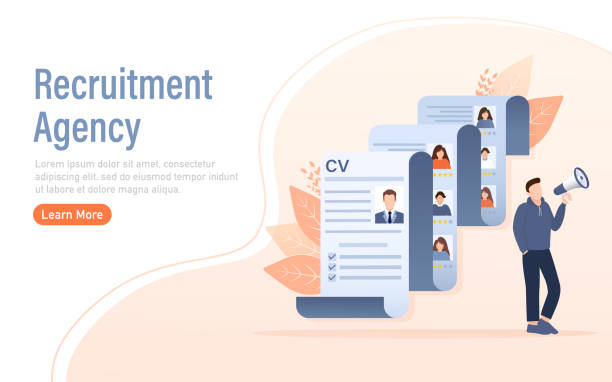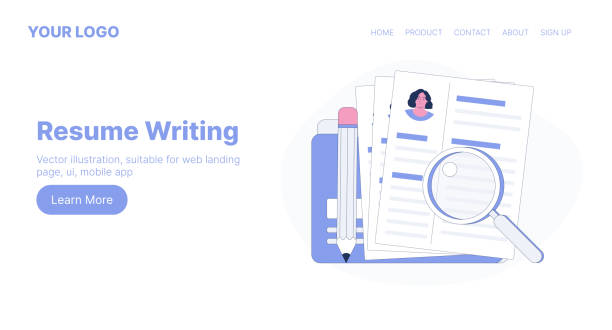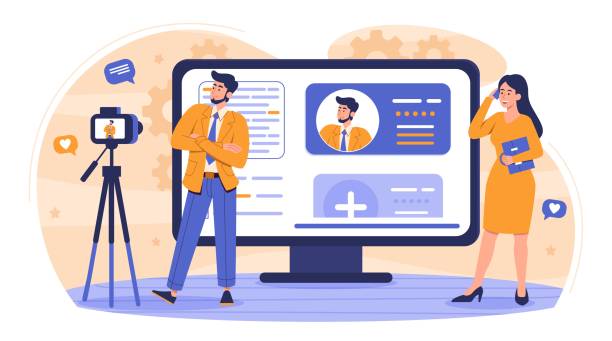Introduction to User-Friendly Website Design: Why Is It So Important?

In today’s world, user-friendly website design is no longer an option, but a necessity for every online business.
This concept goes beyond visual aesthetics and focuses on the ease of use and efficiency of a website.
The main goal of user-centric website design is to create an enjoyable and hassle-free experience for visitors, so they can quickly and easily access the information they need and interact effectively with the site.
User-focused website design means understanding user needs, behaviors, and limitations, and then, based on this understanding, creating a logical structure and intuitive navigation.
This approach not only increases customer satisfaction but can also significantly boost conversion rates and foster long-term user loyalty to your brand.
In fact, a well-designed website that prioritizes user needs acts like a skilled salesperson who guides the customer toward their goal, without confusing or tiring them.
This is crucial for success in today’s competitive online landscape.
#Usability #UserExperience #SuccessfulWebsite
Are you worried about the low conversion rate of your online store and not achieving your desired sales?
Rasaweb is your specialized solution for having a successful online store.
✅ Significantly increase conversion rates and sales
✅ Professional and user-friendly design to attract customer satisfaction
⚡ Ready for a transformation in online sales? Get a free consultation!
Fundamental Principles of User Experience (UX) in User-Friendly Website Design

To achieve a user-friendly website design, understanding the principles of User Experience (UX) is essential.
UX goes beyond User Interface (UI) and encompasses all aspects of user interaction with a product or service.
The first principle is “Usability”; meaning users should be able to easily navigate the website, complete their tasks, and access the information they need.
This includes clarity in layout, simplicity in forms, and predictable functionality of buttons and links.
The second principle is “Accessibility”; meaning the website should be usable by people with different abilities (such as individuals with visual or motor impairments).
This is not only an ethical requirement but can also significantly expand your target market.
The third principle is “Efficiency”; users should be able to complete their tasks with minimal effort and time.
This includes optimizing processes, reducing unnecessary steps, and providing quick solutions.
Finally, “Desirability” means creating a positive emotional experience that makes users want to return.
This principle is achieved through attractive visual design, appropriate feedback, and creative interactions.
A customer-centric website design considers all these principles to create a successful online platform.
Effective Information Architecture and Navigation in User-Centric Website Design

One of the main pillars of user-friendly website design is strong Information Architecture (IA) and an effective navigation system.
Information Architecture refers to organizing, structuring, and labeling content in a way that is understandable and discoverable.
This process begins at the very start of design and requires deep analysis of website goals and user needs.
A website with weak IA, even with excellent content, can confuse users and prevent them from achieving their goals.
The Navigation System must also be intuitive and consistent enough for users to always know where they are on the site and how they can move to other sections.
Using clear menus, breadcrumbs, and powerful internal search are key elements in this area.
This educational and explanatory section helps you gain a better understanding of these key concepts.
For example, in an e-commerce website, product categorization should be logical and predictable, so that the user can follow the correct path to find their desired item without much thought.
The table below lists some of the best practices for information architecture and navigation:
| Element | Description | Importance in User-Friendly Website Design |
|---|---|---|
| Main Menu | Clear and consistent hierarchical structure | Quickly guides the user to key sections |
| Breadcrumbs | Indicates the user’s path on the site | Increases spatial awareness and ease of return |
| Internal Search | Ability to search within the site’s content | Quick access to specific content |
| Sitemap | Overall display of website structure | Helps search engines and users understand the structure |
These are just some of the necessary approaches for a user-friendly website design that help users quickly and without confusion find their way on your website.
This type of user-centric website development creates a pleasant experience for visitors.
Visual Design and User Interface (UI) Aesthetics in User-Friendly Website Design

After information architecture and navigation, it’s time for visual design and User Interface (UI), which play a significant role in user-friendly website design.
UI refers to the look and feel of the website and includes elements such as colors, fonts, images, icons, and overall layout.
An attractive and harmonious user interface can build a sense of trust and professionalism in users and encourage them to stay and explore the site further.
Using an appropriate color palette that aligns with your brand, choosing fonts with high readability, and organizing white space to prevent visual clutter are among the aspects that need careful attention.
Also, consistency in visual design across the website is very important; similar elements should appear in the same way on all pages so that the user does not get confused.
This analytical and guidance approach shows how aesthetics can impact user experience.
An excellent user-focused website design is not just about beautiful appearance, but about how that appearance affects user interactions.
UI design must not only be beautiful but also functional and help users complete their tasks.
Combining art and function is the secret to success in customer-centric website design.
Are you worried about losing customers because you don’t have a professional company website?
With professional company website design by Rasaweb, forget these worries!
✅ Significantly increase sales and convert visitors into loyal customers
✅ Professional and user-friendly design that builds customer trust
⚡ Get a free consultation from Rasaweb now!
Responsive Design and Mobile-First Approach in User-Friendly Website Design

In the current era, where the use of mobile devices for internet access has become extremely common, user-friendly website design would be incomplete without considering a Responsive Design approach.
Responsive design means that your website should be able to automatically adapt its appearance and functionality to the screen size of the device the user is using (whether it’s a computer, tablet, or smartphone).
This provides a consistent and optimized user experience across all platforms.
The “Mobile-First” approach is also a design philosophy where website design begins with the smallest screen (mobile) and then gradually expands to larger screens.
This method ensures that the most important content and functionalities are displayed correctly on the mobile version and that the user experience on these devices is not compromised in any way.
This section contains specialized and news-related information about the importance of these approaches.
Google, as one of the most important SEO factors, prioritizes responsive websites in its rankings.
A truly user-friendly website design means a site that is accessible on any device without any issues and does not force the user to zoom or horizontal scroll.
This type of user-centric website design not only increases user satisfaction but also helps you capture a larger share of mobile traffic.
The Importance of Loading Speed and Performance in User-Friendly Website Design

Website loading speed is one of the most vital factors in user-friendly website design and user retention.
Studies have shown that users expect a website to load in less than three seconds, otherwise, the likelihood of abandoning the site and visiting competitors drastically increases.
Slow loading speed not only disrupts user experience but also negatively impacts SEO and website ranking in search engines.
Image optimization, compression of CSS and JavaScript files, using caching, and choosing a powerful hosting are among the solutions that can help improve loading speed.
This analytical and explanatory section shows you how every millisecond matters.
A user-centric website design should always prioritize speed, as today’s users are more impatient than ever.
Even a beautifully designed website with excellent content will not achieve its goals if it loads slowly.
Continuous monitoring of site speed with tools like Google PageSpeed Insights and GTmetrix is essential to identify bottlenecks and take action to improve them.
This attention to technical details makes the difference between an ordinary website and a successful user-friendly website design.
Content Strategy for Greater Engagement in User-Friendly Website Design

Content is king, but not just any content; content that aligns with user-friendly website design reigns supreme.
Content strategy refers to the planning, production, and management of valuable, relevant, and consistent content to attract, engage, and retain audiences.
Your content should not only provide users with the information they need but also answer their questions and solve their problems.
Using engaging headlines, short and readable paragraphs, bulleted lists, and relevant images and videos can significantly increase content readability and attractiveness.
Thought-provoking and guiding content can maximize user engagement.
For example, a blog with specialized and educational articles, or an FAQ section with comprehensive answers, can keep users on your site for a longer period.
Also, optimizing content for search engines (SEO Content), meaning using relevant keywords, meta descriptions, and appropriate internal and external links, is of high importance.
A customer-centric website design presents content in a way that is not only useful but also provides an enjoyable reading experience for the user.
The table below shows some types of content and their role in user-friendly website design:
| Content Type | Goal | Impact on User-Friendly Website Design |
|---|---|---|
| Blog Articles | Education, Information, Credibility Building | Increases dwell time, attracts organic traffic |
| Product/Service Pages | Sales, Detail Presentation | Increases conversion rate, reduces bounce rate |
| FAQ Section | Answers common questions | Reduces support calls, increases trust |
| Videos and Infographics | Provides engaging visual information | Increases engagement, simplifies understanding of complex concepts |
By focusing on producing valuable and planned content, we can ensure that our user-friendly website design is not only visually and technically excellent but also rich and compelling in terms of content.
User Testing and Feedback Collection for Continuous Improvement of User-Friendly Website Design

One of the critical steps in the user-friendly website design process is user testing and feedback collection.
A website is never truly “finished” and always has room for improvement.
User testing helps identify weaknesses, navigation issues, and areas where users face challenges.
These tests can be conducted in a focused manner (with real users) or in a distributed manner (using analytical tools).
Observing how users interact with the site, asking questions, and gathering their suggestions provides valuable insights that no designer or developer can achieve alone.
This educational and specialized approach emphasizes the importance of truly understanding user needs.
Additionally, using tools like heatmaps, user session recordings, and online surveys can provide important quantitative and qualitative data.
After collecting feedback, you must analyze it and, based on priority, implement the necessary changes to the website.
This continuous cycle of testing, feedback, and improvement ensures that your user-centric website design is always evolving and improving, keeping pace with changing user needs.
Remember that the ultimate goal of any user-centric website development is to provide the best possible experience to visitors, and this is not possible without listening to them.
Are you tired of losing business opportunities due to not having a professional company website?
Rasaweb, with its professional company website design, helps you:
✅ Build a powerful and reliable brand image
✅ Convert website visitors into loyal customers
⚡ Get a free consultation right now!
Accessibility and Inclusivity: Building a Website for Everyone in User-Friendly Website Design

Another dimension of user-friendly website design that has gained increasing importance is Accessibility and Inclusivity.
An accessible website is one that can be used by people with various abilities and disabilities (including visual, auditory, motor, and cognitive).
This is not only a legal requirement in many countries but also an ethical commitment and an opportunity to expand your target market.
Adhering to WCAG (Web Content Accessibility Guidelines) standards, such as providing alt text for images, using appropriate color contrast, enabling keyboard navigation, and offering captions for videos, are among the key measures in this area.
This explanatory and entertaining section reminds you how website design can be appealing and usable for everyone, regardless of their abilities.
An inclusive user-focused website design means removing digital barriers that might prevent some individuals from accessing your information or services.
By creating an accessible website, you not only help the community but also enhance your brand’s credibility and demonstrate that you care about the needs of all users.
This type of user-friendly website design is a bridge connecting everyone to the digital world and brings new opportunities for your business.
The Future of User-Friendly Website Design: Trends and Innovations

The future of user-friendly website design is intertwined with exciting trends that will make the user experience even more intuitive and personalized.
Artificial Intelligence (AI) and Machine Learning (ML) will play an increasing role in this field, from advanced chatbots for customer support to content personalization based on user behavior.
Augmented Reality (AR) and Virtual Reality (VR) are also opening new frontiers in website interactions, especially in areas like e-commerce and entertainment.
Voice search, with the popularity of voice assistants like Siri and Alexa, will also become an important channel for interacting with websites, and user-friendly website design must be optimized for it.
This news-related and analytical section takes a look at the horizons ahead in the world of web design.
Attention to “human-centered design,” which goes beyond user-centricity and considers all emotional and cognitive aspects of humans, will also be a significant trend.
Customer-centric website design in the future will not only mean simplicity and efficiency but also creating unforgettable and profound experiences for users.
Developing websites with more advanced capabilities, more natural interactions, and intelligent responsiveness will be the main focus of user-friendly website design in the coming years.
Frequently Asked Questions
And other services of Rasaweb Advertising Agency in the field of advertising
Smart Marketing Automation: Professional optimization for online growth using Google Ads management.
Smart Brand Identity: An effective tool for analyzing customer behavior with the help of intelligent data analysis.
Smart Social Media: An effective tool for increasing sales with the help of custom programming.
Smart Brand Identity: An effective tool for analyzing customer behavior with the help of precise audience targeting.
Smart Marketing Automation: A new service to increase customer behavior analysis through user experience customization.
And over hundreds of other services in the field of internet advertising, advertising consulting, and organizational solutions
Internet Advertising | Advertising Strategy | Advertorials
References
User Experience (UX) Principles, Responsive Design, SEO Optimization for New Websites, Choosing the Best Website Design Platform
? With Rasaweb Afarin, your business shines in the digital world! With our expertise in key areas of digital marketing, including multilingual website design, Search Engine Optimization (SEO), and professional social media management, we are ready to elevate your brand to the top.
📍 Tehran, Mirdamad Street, next to Bank Markazi, Kazerun Jonubi Alley, Ramin Alley No. 6


